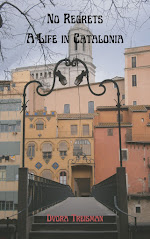Most Americans and Brits who enjoy wine drink French or California wines. Some, who read the reviews, have sipped the occasional Rioja or Ribera del Duero. And some who follow the latest trends know about the wines of Priorat which have finally put Catalunya on the wine-lover’s map. The Priorat is about an hour away from me. The Terra Alta (highlands), yet another wine-growing region, is even closer, so, being a believer in buying locally, I drink their undiscovered wines the most.

While the Terra Alta is hilly, Priorat is comprised of steep, rocky terrain full of slate, and that is what gives the wine its distinctive flavors. There are virtually no flat fields so the vineyards are all terraced into the hillsides. The wineries in both these areas tend to be small enterprises, most of them harvesting and making their wines by hand.
There is no real city in either Priorat or the Terra Alta. The biggest settlements are small towns like Falset (population 2,600), and mostly you find only small villages. In almost every one of these small villages you find a building – usually in the modernist style – housing the village’s wine cooperative. In Pinell de Brai (population 1,075) you find the Catedral del Vi (Cathedral of Wine).

Designed in 1917 by the Catalan architect Cèsar Martinell i Brunet, a disciple of Antoni Gaudi, in the modernist (Catalan art nouveau) style, this cooperative has always been a working building, a winery and olive press, and is made of simple materials, brick and stone. What makes it stand out from the other modernist cooperatives is the ceramic frieze across its façade and the elegant parabolic arches inside, typical of Catalan modernist architecture, but not always so grand. It is these arches that give one the feeling of being in a cathedral.
Martinell designed several wine cooperatives in the area, all of them notable and noticeable when you drive through the villages where they are located. The one in Pinell de Brai is perhaps the most splendid of them all, although the village is no bigger or richer than any of its neighbors. Evidently the people of this village were somehow inspired in 1917 to make something exceptional. The members of all the cooperatives spent more money than they needed to in order to have these utilitarian buildings built. They could have opted for something very basic and utilitarian. But no, these people, in one village after another, chose to erect something more expensive, something lasting, something very beautiful.
 While the Terra Alta is hilly, Priorat is comprised of steep, rocky terrain full of slate, and that is what gives the wine its distinctive flavors. There are virtually no flat fields so the vineyards are all terraced into the hillsides. The wineries in both these areas tend to be small enterprises, most of them harvesting and making their wines by hand.
While the Terra Alta is hilly, Priorat is comprised of steep, rocky terrain full of slate, and that is what gives the wine its distinctive flavors. There are virtually no flat fields so the vineyards are all terraced into the hillsides. The wineries in both these areas tend to be small enterprises, most of them harvesting and making their wines by hand. Designed in 1917 by the Catalan architect Cèsar Martinell i Brunet, a disciple of Antoni Gaudi, in the modernist (Catalan art nouveau) style, this cooperative has always been a working building, a winery and olive press, and is made of simple materials, brick and stone. What makes it stand out from the other modernist cooperatives is the ceramic frieze across its façade and the elegant parabolic arches inside, typical of Catalan modernist architecture, but not always so grand. It is these arches that give one the feeling of being in a cathedral.
Designed in 1917 by the Catalan architect Cèsar Martinell i Brunet, a disciple of Antoni Gaudi, in the modernist (Catalan art nouveau) style, this cooperative has always been a working building, a winery and olive press, and is made of simple materials, brick and stone. What makes it stand out from the other modernist cooperatives is the ceramic frieze across its façade and the elegant parabolic arches inside, typical of Catalan modernist architecture, but not always so grand. It is these arches that give one the feeling of being in a cathedral.









Here in the States, I can't find a Priorat for less than about $20...are the prices more reasonable in Catalonia?
ReplyDeleteI buy a Priorat that I like for about 10 euros. They must start lower here since there is no shipping cost, Oi?
ReplyDeleteI usually pay around 3 or 3.50 (euros) for my every day wine (not the cheapest plonk you can find) and 7 to 10 for company. Last year I splurged and bought a bottle of white Priorat (they don't do much white) for over 20. But I can't afford much of that. Still, one needs something special in one's life every now and then.